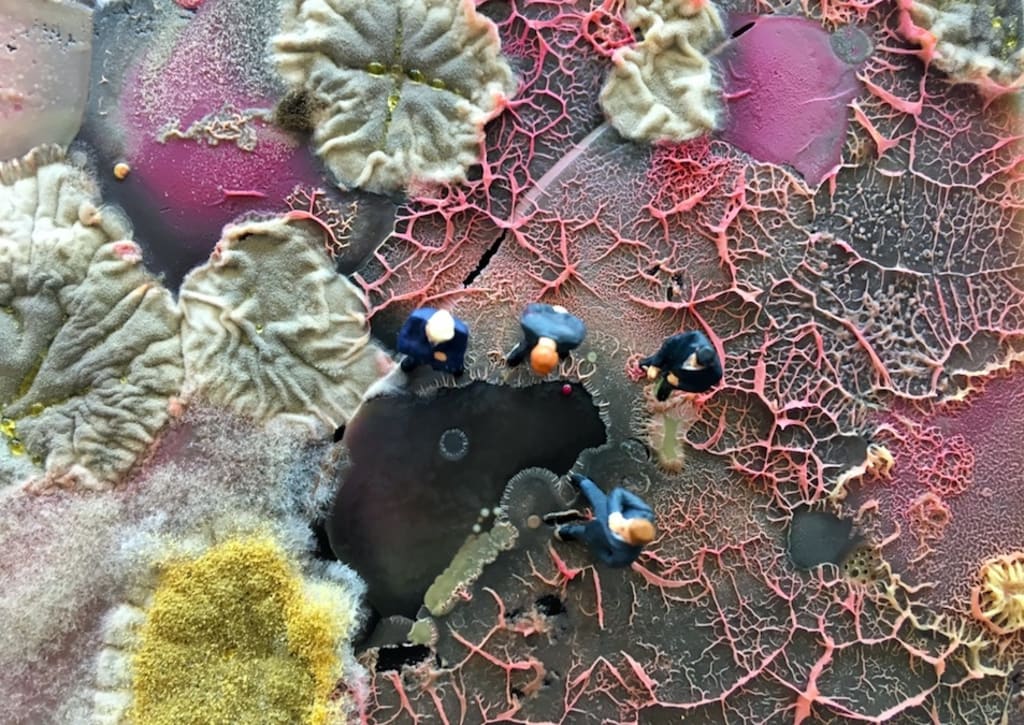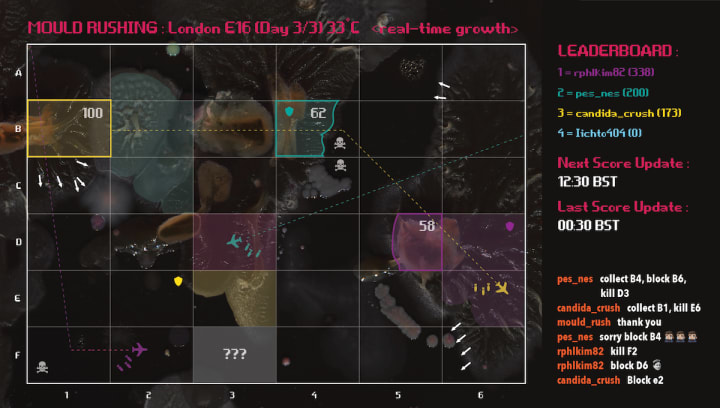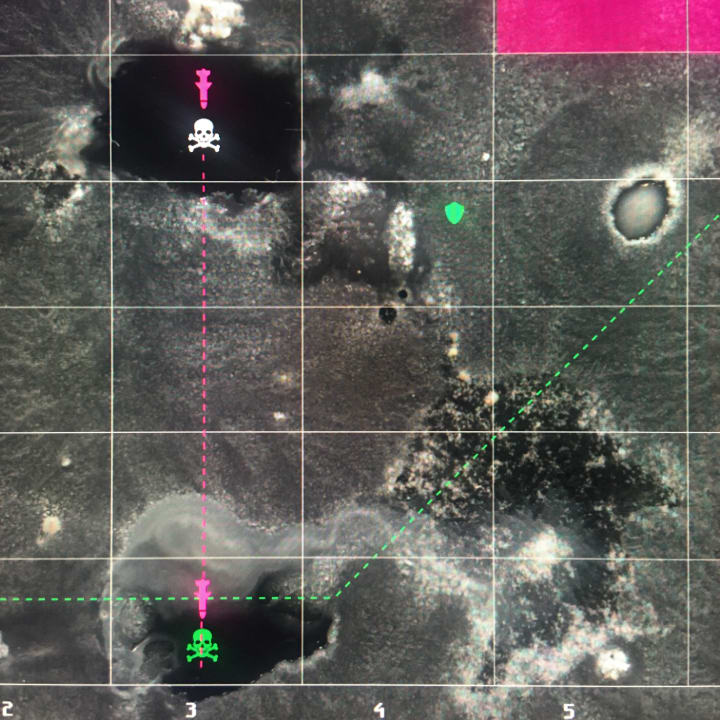Playing Computer Games with… Bacteria?
A Peculiar World of Biotic Gaming

(NB: I confirm that I own the rights to the content, unless otherwise stated).
Picture yourself completely absorbed in a computer game: where you are darting through crumbling urban landscapes, pursued by cordyceps-infected zombies, zapping them with plasma rifles, or engaging in cerebral battles of chess and intricate strategy games. Now, envision this gaming experience where your opponents aren’t merely humans or virtual characters, but rather unconventional (yet very much real and living) entities — such as microscopic bacteria, yeasts, and fungi — adding an entirely different dimension to your gameplay.
Biotic Games, also referred to as hybrid bio-digital games, offer precisely such kinds of experiences. The emerging game genre blends actual biological elements and processes into digital gameplay. Typically featuring living microorganisms, these games task players with manipulating bacterial behaviour using various stimuli such as electrical fields, chemicals, light, and so forth. These kinds of interactions are then translated into virtual characters and displayed (and often live-streamed) on video gaming displays. Their accessible nature has made biotic games a favoured choice among diverse groups, including biology students, artists, and designers seeking to delve into the playful interactions between humans and the microbial world.
I first became aware of biotic games a few years back, when I stumbled upon the designs from Ingmar Riedel-Kruse’s lab that were making waves across social media. One of their most intriguing creations was a game platform called LuduScope. Here, our adversary isn’t your typical character but a living organism known as “Euglena” (also known as Euglena gracilis). These critters hover at the edge of visibility to the naked eye and possess an intriguing sensitivity to light, causing them to instinctively shy away from light sources. The brilliance of LuduScope and one of its games, Euglena PacMan, lies in how they have this very trait.
The gameplay is a set of nudges and control: Players manipulate Euglena by strategically directing light using a joystick embedded with LED lightbulbs positioned at various angles. By manoeuvering the joystick, players emit light in different directions, compelling the Euglena to swim in opposition to the light source. The spectacle of gameplay comes alive through an eyepiece and an objective lens attached to a smartphone’s camera, translating Euglena’s movements onto the smartphone screen. Virtual overlays on the screen create an augmented reality, enhancing the gaming experience. It’s a mesmerizing fusion of biology and technology, where players engage in a visually captivating, real-time interaction with these microorganisms, all through the lens of a smartphone and a joystick.
Why Microbes?
At this point, you might be wondering, why on earth someone would want to design and play such games? There are several reasons behind this.
One major motivation, particularly for Riedel-Kruse’s research group, lies in education and scientific research. Their focus revolves around introducing people to the fascinating behaviours of organisms like Euglena in a manner that’s both entertaining and informative. Take, for instance, the aforementioned LuduScope, which not only facilitates gameplay but also enables digital documentation, online sharing, and analysis of Euglena behaviours. These efforts essentially blend education and entertainment, infusing a microbial twist into what can be termed as (biotic) edutainment.
Additionally, Zahid Hossain and colleagues expanded the notion of edutainment by exploring a similar educational method centred around the slime mould Physarum Polycephelum. This innovative approach aimed to improve how we conduct playful and interactive biology experiments by overcoming various hurdles such as training requirements, expenses, safety issues, logistical challenges, and spatial constraints. The researchers introduced a fresh concept: a novel cloud-based experimentation setup, which allowed for conducting diverse plays and experiments remotely, simultaneously, and interactively.
For others, they are drawn to biotic games simply because of the novelty they offer. People are simply fascinated by the unusual aesthetics and peculiar appearances, such as those found in microbes. Further still, the fact that these organisms are alive adds another layer of fascination, demonstrating the concept of biophilia and our natural curiosity and attraction toward all living things.
Mould Rush
For me, as part of my (now completed) Ph.D research project, I decided to have a go at designing and playing a biotic game myself. This resulted in the creation of a game called Mould Rush, designed to facilitate playful interactions between human players and the microbial world.

I would describe this game as a part-physical, part-virtual, online multiplayer strategy game, that is played on a slow but constantly-evolving landscapes shaped by real, living micro-organisms in the form of common household “mould”. As mould gather and grow in different colours and shapes, shifting their colonial mass across a nutrient-filled agar matrix, the organisms are imaged at regular intervals by an automated, high-resolution flatbed scanner. The result is a continuous generation of images that capture growth in real-time, allowing the players to observe visual changes as and when they occur; albeit rather slowly.
The transition from one image to the next is then live-streamed on Twitch, where the game is played and moderated. Mould Rush is the first biotic game to be live-streamed on Twitch, making its debut on the 13th of June, 2018.
The goal of Mould Rush game is to compete with fellow Twitch viewers and collect as many microbial cells as possible, over a five-day period. With the help of a virtual grid that is overlaid over the image of microbes, players select individual segments containing cells inside, by relaying commands on Twitch chat box. Points are awarded based on the coverage of cells in the selected segment, and it is calculated using an image processing tool such as Open CV.

Additionally, players can physically kill and clone cells, that are found in segments of their choosing, in order to strategically attack the opposition, and to expand the player’s colony. The commands for these actions are executed by the moderator during the gameplay broadcast. Using manual laboratory techniques such as micro-pipetting and sterile loop inoculation, the commands are fulfilled.
My intention behind designing this game was that by playing Mould Rush, players could not only learn about the fundamental concepts of microbiology — such as cell culturing, colony morphology, and colony behaviour — but also a lot more.
Embracing Slowness (and Messiness) of Biology
In addition to the educational value Mould Rush provides, the game also encourages players to appreciate the natural slow pace of microbial growth and the beauty it offers and to develop memory and observation skills, as well as patience and perseverance.
The slow pace of microbial growth in Mould Rush means that player actions don’t immediately show visual feedback, a trait that is often observed in most conventional video games. This is because a typical bacterial or fungal growth can only be made visible to the human eye after several hours of incubation, and other species may take much longer, meaning that players need to exercise patience (often for several hours or days) to see the results of their commands.
Looking at another type of slow games that have been introduced to the public, Mould Rush is somewhat akin to the turn-based games like Correspondence Chess played via mail or forums, or modern creations like Ishac Bertran’s Slow Games, which comprises a series of three physical cubic consoles with minimal interfaces for interaction that allows only one move per day from the player. Slowing down the game pace removes the need for quick hand-eye coordination and the intense concentration required in traditional video games. Instead, slow games invite us to challenge our memory, capacity for observation, and patience.
Biology is also inherently messy. In Mould Rush, micro-organisms grow in relaxed conditions using a ‘non-selective media,’ allowing different species to thrive. As such, a typical Mould Rush game produces a wide and often unpredictable mix of microbial communities. Mould Rush promotes and celebrates this method of culturing, resulting in a visually diverse array of microbial communities. It not only enhances the dynamics of the gameplay but may also help gamers to keep visually engaged, an experience that can often be challenging to maintain, during a slow-paced game.
Future Perspectives
So there you have it, a quick glimpse at the weird and wonderful world of biotic gaming. Its potential for uptake and applications looks promising. As we observe the emergence and growth of the global Do It Yourself (DIY) biology movement, tools and materials of biotechnology are becoming more accessible and affordable, especially to those outside of the confines of conventional professional laboratories.
Advances and increasing accessibility of digital technologies too, promise rich opportunities for biotic gaming. Given the slow and continuous nature of Mould Rush gaming sessions, making the game available on smart mobile devices could also facilitate the player experience. It would allow the game to be played constantly, at any time, and at any location with an internet connection. Furthermore, the use of a cloud storage system in Mould Rush has helped its players to analyse the growth images remotely, away from the actual living cells. Such a cloud system would benefit the players of similar biotic games in the future, especially if the game develops further into an educational or research-based application that generates scientific data. A recent development of cloud-based labs that are specifically designed to facilitate real-time and remote experimentation of biological matters offers some insight into this potential. And finally, Internet-based biotic gaming would prove useful from a practical point of view. It would allow off-site gaming, whereby players are safely away from potentially harmful biological interactions.
Resources
Traditionally feared and fermented, microbes can now be readily explored using computers and accessible materials from the comfort of your own home. Why not give it a try? No longer will your video gaming opponent be limited to virtual fungal-infested clickers and bloaters (e.g., as seen in The Last of Us), but an actual breathing and living colony of fungi themselves.
But before you start donning gas masks and latex gloves, as a starting point, this publication by Lukas Gerber and colleagues will give you a general approach towards identifying potentially interesting microbes and their behaviours, along with guidelines on setting up a biotic game of your own. Have fun!
About the Creator
Raphael Kim
Independent researcher, writer, and educator: On topics around microbes, DNA, and AI. Ph.D in hybrid bio-digital gaming with living microbes
Enjoyed the story? Support the Creator.
Subscribe for free to receive all their stories in your feed. You could also pledge your support or give them a one-off tip, letting them know you appreciate their work.






Comments
There are no comments for this story
Be the first to respond and start the conversation.